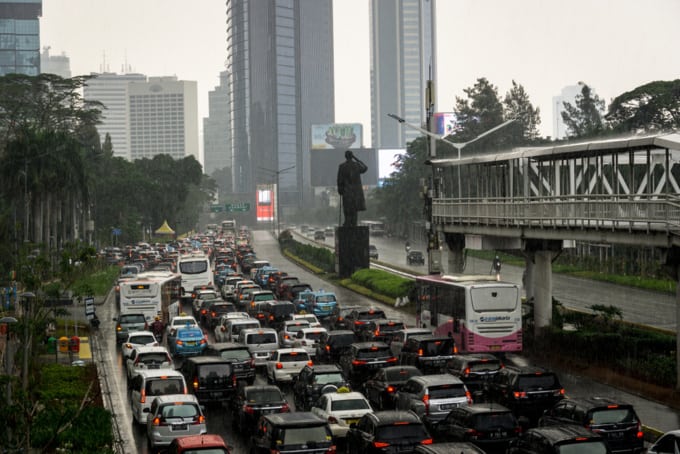
The cities facing climate change
4 minutes of reading
Not all cities are equal in the face of climate change. Some have published and committed to resilience strategies. Others are slow to take action … or simply give up entirely.

French scientists have recently revised up global warming figures, predicting +7° by 2100. Studies led by the country’s National Centre for Scientific Research (CNRS), the Commissariat for Atomic Energy and Alternative Energies (CEA) and Météo-France revealed in mid-September, terrifyingly, that 70% of the world’s population will be living in towns and cities by the year 2050. It’s primarily these towns and cities that are responsible for adhering to the Paris Climate Agreement. They’re part of the problem (towns and cities consume two-thirds of the world’s energy and are responsible for 70% of greenhouse gas emissions) but they’re also potential disaster victims and must find solutions for the future as our political centres of activity and the veritable engines of our economies (generating 80% of our GDP), as well as being centres of innovation.
The latest government reports have reminded us of the efforts needed to stay below the 2° mark. No longer selling fossil-fuelled cars by 2035, reducing building emissions by at least 80% from their current level by 2050, achieving carbon neutral status by 2050, reducing CO2 emissions by 50% by 2030 … these aren’t natural evolutions, but radical changes that society must face up to.
Because change is already here. Children will soon no longer read in geography books, for example, that Paris is an “ideally temperate” city. In 2003, a heatwave in the French capital killed 700 of its residents. Climate change will only make such heatwaves more frequent and intense. And while Paris is one of the largest European capitals, it only has 14.5 m2of green space per capita, against 45 m2in London and 321 m2in Rome. Stone and asphalt, the impervious surfaces that cover the city not only increase intramural heat, but also the city’s vulnerability to flooding, particularly during so-called “100-year floods”.
France’s capital has committed to an “exemplary” resilience strategy, shared on the “100 Resilient Cities” network, of which it is a member
“When we developed our strategy”, explains Noémie Fompeyrine, responsible for resilience projects at Paris City Hall, “school and college playgrounds caught our attention”.They add up to some 70 hectares of outdoor space throughout the city, all easily identifiable and familiar to local residents. No Parisian lives more than 250 metres away from one of these yards. They could easily become locally-accessible public spaces, outside the school day”. Paris’ resilience strategy plans to renovate 761 playgrounds, transforming each one into an “oasis”, “designed with local residents and sometimes by the children themselves”, she explains. The ground, either soil or covered with a porous coating and painted in natural colours, will be shaded by orchards as part of an educational garden. This kind of “oasis” will ensure both a decrease in temperature in the summer and milder winters, while facilitating the flow of water during storms. “Thanks to this type of oasis, we’ll achieve a maximum number of our targets: reinforcing social bonds, biodiversity, minimising the risk of flooding, reducing our environmental footprint, as well as providing educational support”. Three pilot schemes have been launched in the 12th, 18thand 20th arrondissementsof Paris at a cost of 1 million euros.Only a quarter of European cities have so far taken action
They’re denying the problem”, according to philosopher Dominique Bourg,“so that it simply goes away”. But it isn’t just a climate catastrophe that cities will face, but rather several simultaneous cataclysms, according to a study published in November 2018 in the Nature Climate Changejournal. Coastal areas will be most vulnerable, and not all cities are equally resilient to modern climate challenges. “New York spends freely to protect itself from rising water levels” was the Le Figaroheadline on 25 October. But St. Martin in the West Indies, for example, devastated two years ago by Hurricane Irma, which left eleven dead and almost 8,000 of its 35,000 residents displaced, is struggling to prepare for the future. “We need to build more resiliently, but it costs four times as much to integrate earthquake protection”, explains Daniel Gibbs, Chairman of the Regional Council. “Cost isn’t the only barrier, administrative red tape is another”, he continues. “Resilience is a slow, laborious process; it requires long-term vision and a great deal of flexibility”, adds Noémie Fompeyrine. “But the climate clock is ticking faster and faster than ever. For short-termists, the challenge isn’t sustainable”. As such, Indonesian President Joko Widodo announced the move of his capital city from Jakarta to the island of Borneo. Polluted and overcrowded, it is particularly threatened with becoming engulfed. “At the current rate, a third of thecity could be under water by 2050, according to environmental experts. The weight of buildings and skyscrapers is further weakening the foun dations of the city, which was built on swamps”, published the Les Echosnewspaper on 16 August. The inequality amongst our cities can be seen in their relationships with nature, depending on their ability to get along – or not – with Mother Nature, instead of trying to challenge her. Philosopher Joëlle Zask spoke of the “anthropisation of nature” to define this relationship of maintenance and partnership. Only the best infrastructure – green infrastructure – can help promote resilience by absorbing carbon, reducing the risk of flooding, regulating temperature, reducing noise … An American study on the role of public space in social cohesion (Public Space Design and Social Cohesion, Patricia Aelbrecht, Quentin Stevens – 2019) underlined the benefits of public parks in Philadelphia. They save a hundred times more than they cost every year, including avoided expenses for flood and storm management, antisocial behaviour, healthcare … all nature-based solutions – a concept that has emerged alongside resilience. And that’s certainly no coincidence.More reading
Read also




What lies ahead? 7 megatrends and their influence on construction, real estate and urban development
Article
20 minutes of reading

